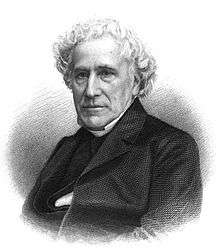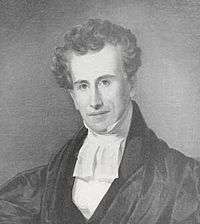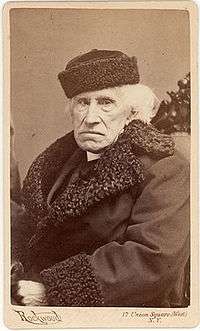William Augustus Muhlenberg
| William Augustus Muhlenberg | |
|---|---|
 | |
| Born |
September 16, 1796 Philadelphia, Pennsylvania, United States |
| Died | April 8, 1877 (aged 80) |
| Nationality | American |
| Occupation | Clergyman, educator |
| Known for | Religious education |
| Religion | Christianity (Anglican Communion) |
| Signature | |
|
| |
William Augustus Muhlenberg (16 September 1796 – 8 April 1877) was an Episcopal clergyman and educator. Muhlenberg is considered the father of church schools in the United States. An early exponent of the Social Gospel, he founded St. Luke's Hospital in New York City. Muhlenberg was also an early leader of the liturgical movement in Anglican Christianity. His model schools on Long Island had a significant impact on the history of American education. Muhlenberg left his work in secondary education in 1845.
Biography
Muhlenberg was born in Philadelphia on September 16, 1796. He was a great-grandson of Henry Melchior Muhlenberg (1711–1787, known as the father of Lutheranism in America) and a grandson of Frederick Muhlenberg (1750–1801), a member of the First and Second Continental Congresses and Speaker of the House of Representatives. Muhlenberg was educated at the Philadelphia Academy and the Grammar School of the University of Pennsylvania, graduating from the university in 1815. In 1817 he was ordained a deacon in the Protestant Episcopal Church, becoming assistant to Bishop William White (1748–1836) in the rectorship of Christ Church, St. Peter's and St. James' in Philadelphia. At this time Muhlenberg was influenced by his older friend, Jackson Kemper (1789–1870), who became the first Missionary Bishop of the Protestant Episcopal Church in 1835.
In 1820 Muhlenberg was ordained a priest, and until 1826 he was rector of St. James' Church in Lancaster. Largely due to his efforts, Lancaster was the second public-school district created in the state. His interest in church music (particularly hymns) prompted his 1821 pamphlet, A Plea for Christian Hymns, and he compiled Church Poetry in 1823 for his parish. That year Muhlenberg was appointed by the General Convention to its committee on psalms and hymns. Its collection (approved in 1826) contained several of Muhlenberg's compositions, including I Would Not Live Alway, Shout the Glad Tidings and Saviour, Who Thy Flock Art Feeding.

Church-school movement
From 1826 to 1845, Muhlenberg was rector of St. George's in Flushing, Queens. In 1828 he became "Principal" of the "Church Institute" in Flushing, where he initiated a unique and highly successful method for the education of boys. In 1836, the cornerstone was laid for a new educational enterprise a mile north of Flushing. This more ambitious initiative was named St. Paul's College and Grammar School. (College Point in present-day Queens County NY is where Muhlenberg's school was situated.) Richard Upjohn designed a magnificent main building. The foundations for the building were completed by 1837 and the edifice of pink stone and white marble began to rise on the hill above Long Island Sound. It was not only the unfortunate financial Panic of 1837 but the party squabbling within the Episcopal Church that prevented Muhlenberg from collecting on the pledges to capitalize and endow St. Paul's. Without adequate endowment, the state legislature denied Muhlenberg's request for a collegiate charter, which meant that St. Paul's could not legally grant the degree of Bachelor of Arts. The ruination of St. Paul's left a lasting wound in Muhlenberg's heart. One of the greatest educators in American history—admired by even public school promoters—departed Long Island for good in 1847. But Muhlenberg's philosophy and practice of education had already been handed over to younger men who made a monumental contribution to the history of American education (see John Kerfoot, James Lloyd Breck, and Henry Augustus Coit).
Educational principles
Muhlenberg disapproved of the "fine literary institutions" springing up throughout the United States during his lifetime. His schools were Christian communities, molding a Christian character rather than pursuing academic excellence alone. Muhlenberg defined character as not only moral goodness, but also the qualities, skills and attitudes favoring effectiveness in the world (for example, to manage a challenging course of study). Academic excellence would inevitably follow.
His schools were Christian families, with Christ as the head, and by "church school" he meant a part of the Body of Christ in which divine grace (God's help) was present for the believer. Muhlenberg and his successors considered the school as the scholastic church. A practical Christian, his Christianity was more practice than theology. Echoing John Henry Newman, Muhlenberg believed that "there can be no such thing as Christianity in the abstract." One of the least sectarian religious leaders of his generation, he realized that unless a religious school teaches a particular religion it would become secular or splinter into factions. A lasting, healthy religious tolerance in a community is enabled by a religious center (or established discipline) from which hospitality and tolerance radiate to the community.
Muhlenberg's experience in public schools from 1818 to 1826 impressed him with the importance of Christian education, and he wanted the Flushing school to build Christian character with denominational instruction. In his 1828 pamphlet The Application of Christianity to Education, he assumed that a moral education would be based on Christianity because of his belief that God revealed himself in a particular way through Jesus Christ. Muhlenberg was confident that through the Bible, humans can glimpse the will of God and a moral education is based on knowledge of that will. A classical scholar familiar with moral goodness in the pagan world, to him the Gospel and Christianity were true and the best education would incorporate them. To Muhlenberg, virtue was synonymous with Christ.
According to his 1828 pamphlet, "The Law of God is the law of the school" as a pattern or blueprint. Muhlenberg strongly discouraged public comparison of weaker to stronger students, and rarely administered corporal punishment; both distinguished him from most contemporary American educators.
The schools at Flushing and College Point were happy, busy scholastic brotherhoods. James Lloyd Breck (1818–1876) spent five years on Long Island with Muhlenberg and his staff. Although considered an ordinary student, he entered the University of Pennsylvania as a third-year student and graduated magna cum laude the following year. After divinity school, Breck went west and founded three seminaries (including Nashotah House Episcopal Seminary in Wisconsin), four boarding schools, three colleges and twenty parochial schools (including Shattuck-St. Mary's School in Faribault, Minnesota). Well-versed in the spread of Christianity during Late Antiquity, he was a missionary among the Mississippi Chippewa in the North Woods of Minnesota and established Muhlenberg-type schools for Ojibwe students.
For Muhlenberg, education was holistic and comprehensive. His application of Christianity to education resembled the aims of Horace Mann (1796–1859) and Thomas Arnold's work at Rugby School beginning in 1828. Foreshadowing John Dewey, Muhlenberg wrote: "Some great minds are slow in developing, the acorn gives little promise of the oak" and "The head should not be furnished at the expense of the heart." He and his scholastic heirs did not allow religion to usurp academic rigor and high scholastic standards: "Religion should never be held to account for inferior scholarship." According to Henry Coit (1830–1895), a disciple of Muhlenberg, "A high aim is better than a low one."
Impact on American education
Muhlenberg's scholastic models on Long Island were transported to other regions and cultures. In 1842 he helped found Saint James School in Hagerstown, Maryland with his assistant at St. Paul's College and Grammar School, John Barrett Kerfoot, who later became the first bishop of Pittsburgh. For his work in education, Kerfoot received an honorary doctorate from Cambridge University. Henry Augustus Coit (1830–1895), a former student of Muhlenberg and Kerfoot, was the founding rector of St. Paul's School in Concord, New Hampshire (1856). Kerfoot's nephew was the founding headmaster of St. Mark's School in Southborough, Massachusetts (1865). Endicott Peabody (1857–1944) founded Groton School in 1884; acknowledging Muhlenberg's influence, he kept his portrait in his study and referred to Groton as a "church school". The founders of St. George's School in Rhode Island (1896) also cited Muhlenberg as an educational pioneer, and he influenced the 1839 founding of the Episcopal High School in Alexandria, Virginia. Muhlenberg consulted with EHS founding headmaster William Nelson Pendleton, and sent acolyte Milo Mahan (who taught at St. Paul's in College Point) at the request of the Bishop of Virginia. Historian James McLachlan noted the Muhlenberg schools' uniqueness in American Boarding Schools: A History (1970).
Religious beliefs
Muhlenberg's mature religion may be described as Anglican Christianity with an American accent. He opposed the "novelties" of Roman Catholicism and dogmatic Protestantism, affirming the Scriptures and church teaching before the 11th-century East–West Schism. Muhlenberg echoed 17th-century Anglican bishop John Cosin; his church was "Protestant and Reformed ... according to the Ancient Catholic Church." His position was also similar to Edward Bouverie Pusey (1800–1882), an Oxford professor and a leader of the 19th-century revival movement in the Church of England. Muhlenberg was influenced by the Oxford Movement, William White (1748–1836), John Keble, John Henry Newman, Pusey,[1] Richard Hooker (1554–1600) and the Christian tolerance of Jeremy Taylor (1613–1667). As a youth, Muhlenberg memorized the Fifteen Sermons and Analogy of Religion of Bishop Joseph Butler (1692–1752).
Born a Lutheran, Muhlenberg converted to the Protestant Episcopal Church as a boy. Trained in Philadelphia by William White, he began to call his religion "evangelical and catholic." To Muhlenberg "evangelical" meant devotion to Jesus Christ, dedication to the Scriptures and the responsibility to live and share the Gospel. "Catholic" denoted roots in a universal faith and order, with guidelines and discipline. Newman's eight-volume Parochial and Plain Sermons parallel Muhlenberg's views. Muhlenberg worshiped Christ without sentimentality, believing that Jesus lived in his schools, ministered to the sick and dying at St. Luke's Hospital and should be the "study" of youth and adults.
He endeavored to make worship more interesting and memorable for his students. Although several of Muhlenberg's former students and followers became Anglo-Catholics, he was dismayed when Newman converted to Roman Catholicism in 1845. Unthreatened by Darwinism, Muhlenberg wrote patriotic poems and was the first Episcopal priest to hold weekly Eucharist and daily offices. In 1853, he submitted a resolution to the General Convention of the Episcopal Church which became known as the Muhlenberg Memorial. The resolution called for open-mindedness and the freedom of parish clergy to be responsive to parishioner needs, especially concerning Sunday-morning worship.[2] Some of Muhlenberg's papers and articles were published in two volumes from 1875 to 1877 as Evangelical Catholic Papers by Anne Ayres, who also wrote his official biography from papers he saved for her (disregarding his request to destroy them after his death).
Later years

In 1845, Muhlenberg moved to New York City. The following year he became rector of the Church of the Holy Communion, a rent-free church built by his sister Mary A. Rogers. Muhlenberg founded the first American order of Protestant Episcopal deaconesses, the Sisterhood of the Church of the Holy Communion, between 1845 and 1852. His work with the sisterhood led to the 1858 establishment of St. Luke's Hospital, for which his congregation made offerings each St. Luke's Day beginning in 1847. In 1866, Muhlenberg founded the Church Industrial Community of St. Johnland on Long Island. He bought 535 acres (217 ha), with 1.5 miles (2.4 km) of shorefront on Long Island Sound near Kings Park as a home for young, crippled children and the elderly. A moderate rent was charged for the cottages. Muhlenberg died on April 8, 1877 in St. Luke's Hospital, and is buried in the St. Johnland cemetery.
Muhlenberg is honored with a feast day on the liturgical calendar of the U.S. Episcopal Church on April 8, his death day. His reputation as an educator has been partially overshadowed by his extracurricular achievements after his move to New York City.
See also
- Johann Konrad Wilhelm Löhe
- New York Free Circulating Library: The Muhlenberg Branch was named in his memory.
Further reading
- Church Leader in the Cities: William Augustus Muhlenberg by Alvin Skardon (Philadelphia: University Press of Pennsylvania, 1971).
- "Muhlenberg" in David Hein and Gardner Shattuck, The Episcopalians (Westport CT: Praeger, 2004).
- The Life and Work of William Augustus Muhlenberg by Anne Ayres, (New York: Thomas Wittaker, 1889).
- A History of the Episcopal Church by Robert Prichard (Harrisburg, PA: Morehouse Pub., 1999).
- "Episcopal Schools: History & Mission" in Carper and Hunt, eds., Handbook of Faith-Based Schools in the United States (June 2012).
- "Social Vision, Character, and Academic Excellence in Nineteenth-Century America: William Augustus Muhlenberg and the Church School Movement, 1828-1877" by Walter Lawrence Prehn III (Ph.D dissertation, University of Virginia, 2005): University of Michigan online access.
References
External links
| Wikiquote has quotations related to: William Augustus Muhlenberg |
- The Life and Work of William Augustus Muhlenberg by Anne Ayres (Project Canterbury)
- Some American Churchmen by Frederic Cook Morehouse Chapter VIII. William Augustus Muhlenberg
- Muhlenberg, William August (Schaff-Herzog Encyclopedia of Religious Knowledge)
- William Augustus Mühlenberg 1796–1877 (The Cyber Hymnal)
- Life of the Right Reverend John Barrett Kerfoot, D.D. L.L.D., First Bishop of Pittsburgh, by Hall Harrison, M.A., Vol. 1, pp. 46 – 48, published by James Pott & Co., New York 1886 (Google Books)
 Texts on Wikisource:
Texts on Wikisource: